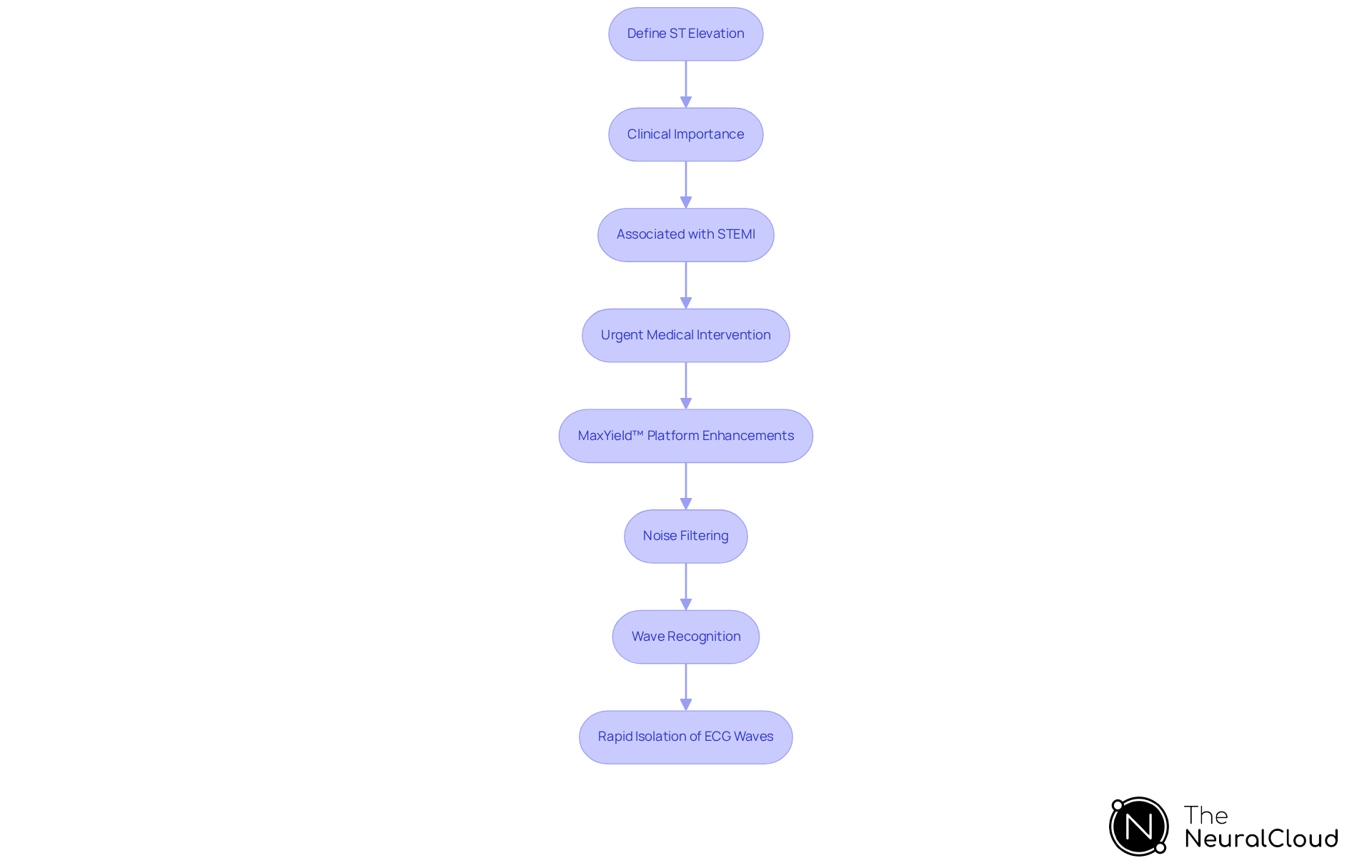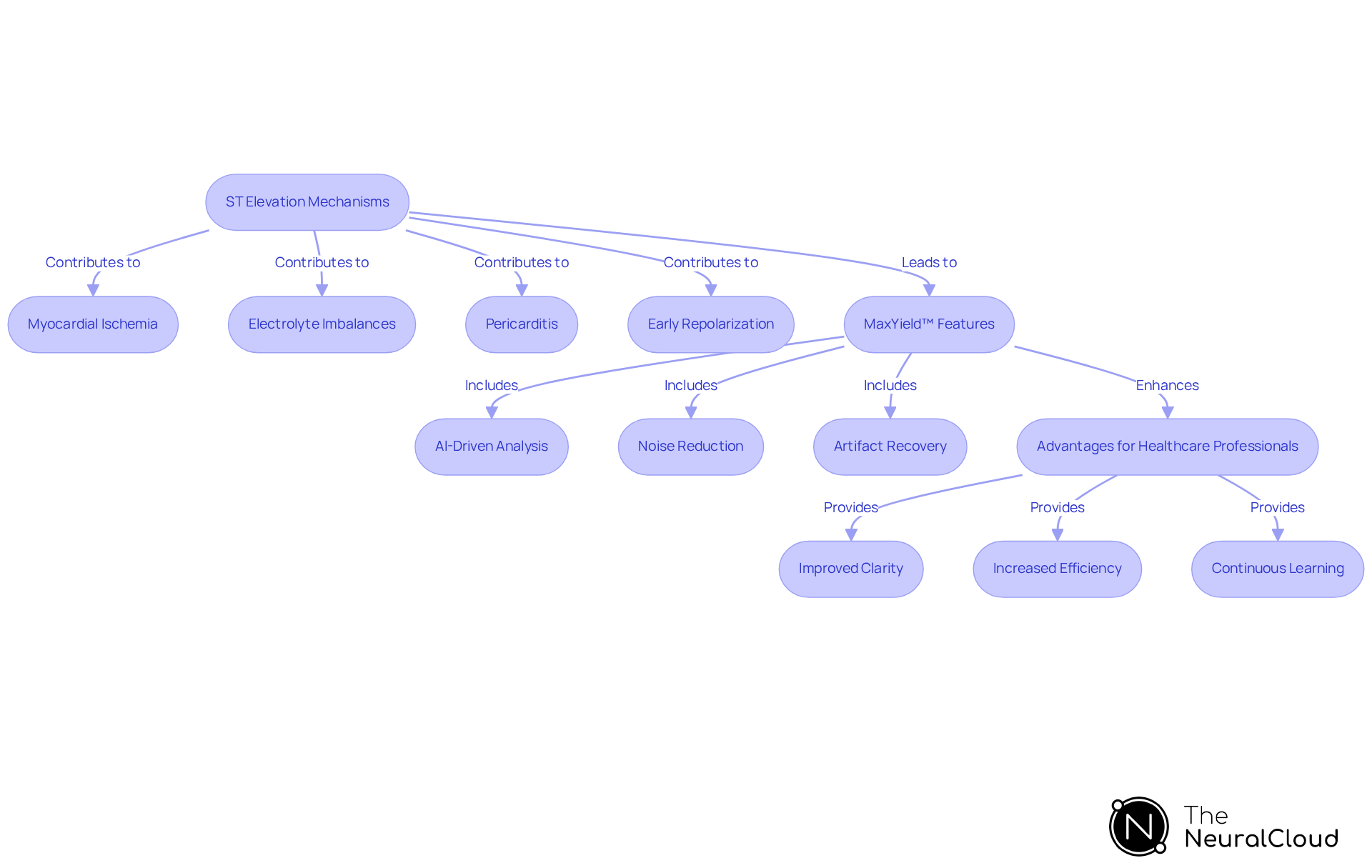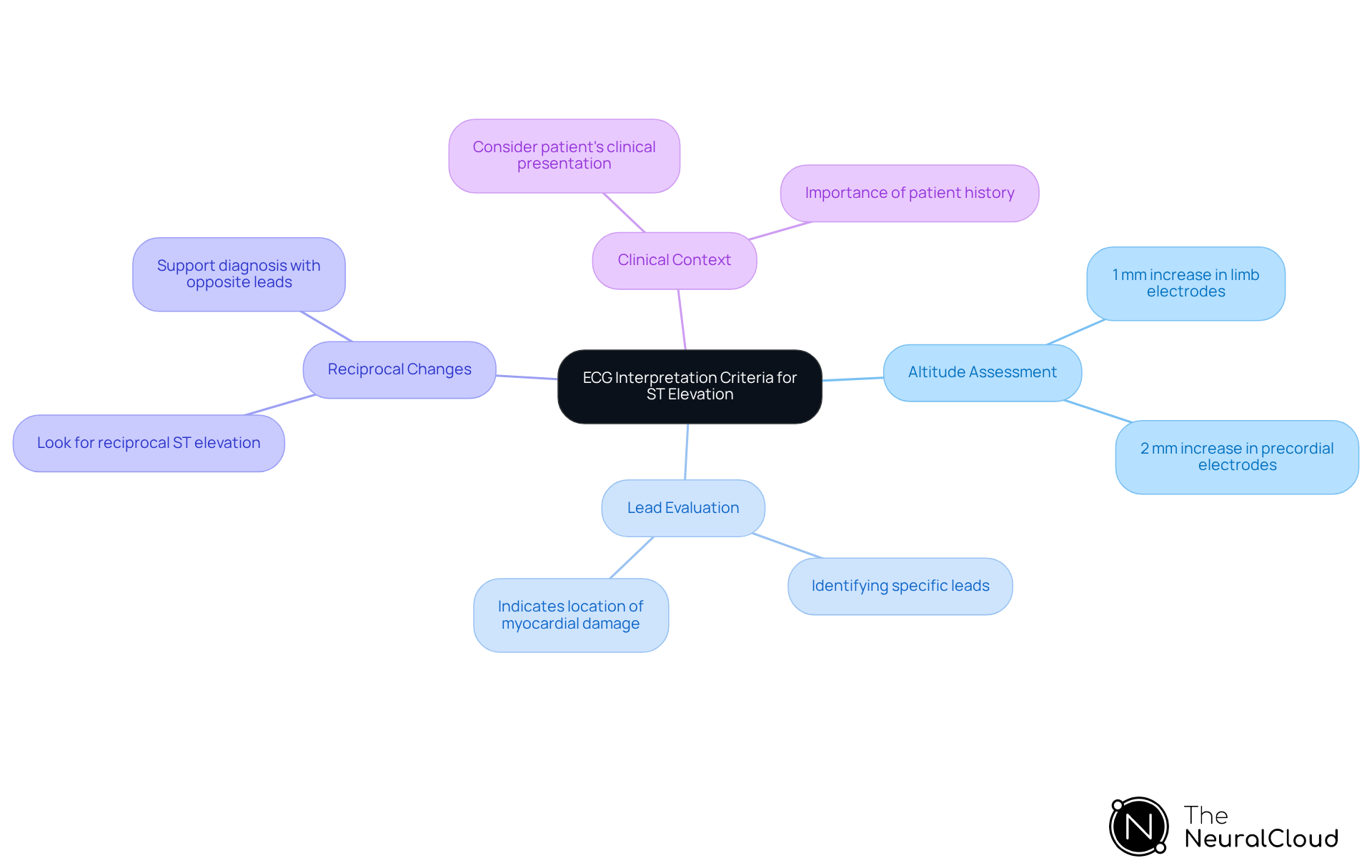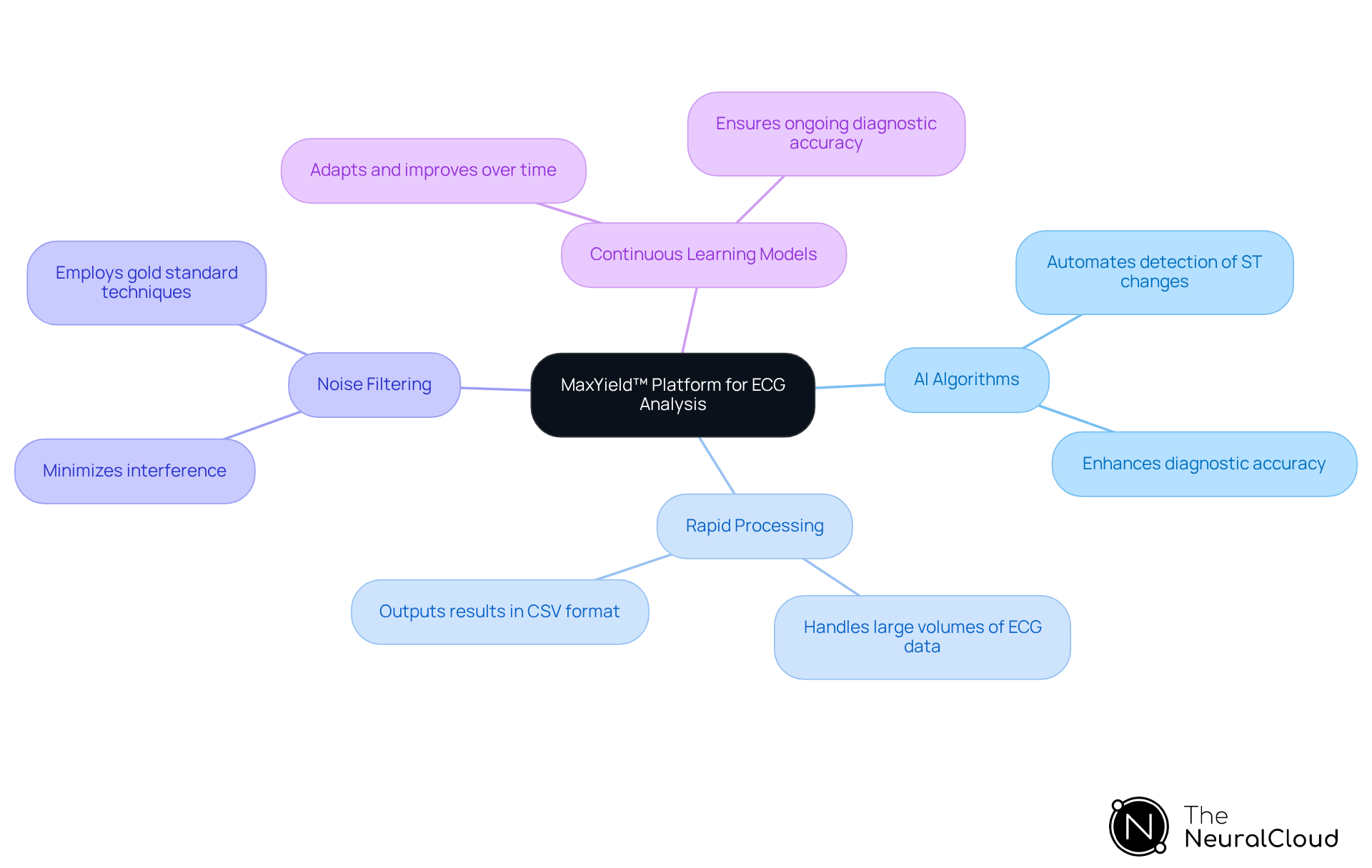Overview
The article delves into the challenges faced in ECG analysis, particularly regarding ST elevation, which serves as a crucial indicator of myocardial injury, especially in ST-Segment Myocardial Infarction (STEMI) cases. Accurate ECG interpretation is essential for effective patient management, yet it often encounters obstacles such as noise and artifacts that can compromise diagnostic precision.
To address these challenges, the MaxYield™ platform offers advanced features designed to enhance ECG analysis. This platform utilizes cutting-edge technology to filter out noise and artifacts, ensuring that the ECG readings are as clear and accurate as possible. By improving the quality of the data, healthcare professionals can make more informed decisions regarding patient care.
The advantages of using the MaxYield™ platform are significant:
- With enhanced diagnostic precision, healthcare providers can better identify myocardial injury, leading to timely interventions.
- This not only improves patient outcomes but also increases the efficiency of healthcare delivery.
- Ultimately, the MaxYield™ platform empowers professionals to manage patient care more effectively, ensuring that critical conditions like STEMI are addressed promptly.
In summary, the MaxYield™ platform stands out as a vital tool in the realm of ECG analysis. By overcoming common challenges and providing clear, accurate readings, it enhances the capabilities of healthcare professionals, leading to improved patient management and outcomes.
Introduction
Understanding ST elevation on an ECG is crucial for timely and effective medical intervention, as it often signals myocardial injury or ischemia. Healthcare professionals face challenges in accurately interpreting ECG readings, particularly when noise and artifacts can obscure critical information. This article explores the mechanisms behind ST elevation and emphasizes the importance of precise interpretation.
The MaxYield™ platform offers advanced features that enhance ECG analysis, providing healthcare professionals with tools to improve diagnostic accuracy. By leveraging cutting-edge technology, the platform streamlines the identification of ST elevation, allowing for quicker responses to potential cardiac events.
The advantages of using the MaxYield™ platform are significant. It not only aids in reducing the likelihood of misinterpretation but also enhances overall patient care by facilitating timely interventions. As we delve deeper into the features of this platform, we will outline how it directly benefits healthcare professionals in their practice.
Define ST Elevation and Its Clinical Importance
ST elevation refers to an upward deflection in the ST segment of the ECG waveform, serving as a crucial indicator of myocardial injury or ischemia. Clinically, this rise in the ST segment is most commonly associated with ST-Segment Myocardial Infarction (STEMI), a life-threatening condition that requires urgent medical intervention. Recognizing ST elevation on ECG can lead to timely treatment, significantly improving patient outcomes.
The MaxYield™ platform addresses the challenges faced in ECG analysis by enhancing efficiency through advanced noise filtering and distinct wave recognition. This system effectively identifies and labels critical data, even in recordings plagued by high levels of noise and artifact. It allows for the rapid isolation of ECG waves from recordings affected by baseline wander, movement, and muscle artifact. Such capabilities are essential for accurately evaluating ST elevation on ECG, ensuring that previously obscured sections of lengthy Holter, 1-Lead, and patch monitor recordings can be salvaged.
As the MaxYield™ platform evolves with each use, it consistently enhances its precision and effectiveness. This ongoing improvement is vital for understanding the standards for ST elevation on ECG, including the level of rise and the specific electrodes involved. Ultimately, this knowledge significantly impacts diagnosis and management approaches, providing healthcare professionals with the tools they need to deliver optimal patient care.

Explore Physiological Mechanisms of ST Elevation
ST rise occurs due to various physiological mechanisms, primarily linked to myocardial ischemia. When blood flow to a part of the heart is obstructed, such as during a coronary artery blockage, the affected myocardial cells become depolarized. This depolarization leads to a rise in the ST elevation on ECG. Additionally, factors like electrolyte imbalances, pericarditis, and early repolarization can also contribute to an increase in ST. Understanding these mechanisms is crucial for distinguishing between pathological and benign causes of ST rise, which can significantly impact patient management.
MaxYield™ from Neural Cloud Solutions addresses the challenges in ECG analysis. Its advanced AI-driven capabilities effectively identify and label critical data, even in recordings with high levels of noise and artifacts. The platform swiftly isolates ECG waves from recordings affected by baseline wander and muscle artifacts, recovering previously hidden sections. This improvement enhances clarity and diagnostic yield, allowing for more precise interpretations of ST elevation on ECG and its underlying causes.
Features of MaxYield™
- AI-Driven Analysis: Automatically identifies and labels critical ECG data.
- Noise Reduction: Isolates ECG waves from noisy recordings.
- Artifact Recovery: Recovers hidden sections for clearer readings.
Advantages for Healthcare Professionals
- Improved Clarity: Enhanced visibility of ECG data leads to better diagnostic accuracy.
- Increased Efficiency: Saves time by streamlining the analysis process.
- Continuous Learning: The algorithm evolves with each use, improving accuracy and efficiency over time.
By utilizing MaxYield™, healthcare professionals can overcome traditional limitations in ECG analysis, leading to more informed clinical decisions and improved patient outcomes.

Apply ECG Interpretation Criteria for ST Elevation
To accurately interpret ST elevation on ECG, clinicians should adhere to established criteria.
Key Points for Interpretation:
- Altitude Assessment: An ST elevation on ECG is typically defined as an increase of 1 mm or greater in the limb electrodes and 2 mm or greater in the precordial electrodes.
- Lead Evaluation: Identifying specific leads with ST elevation on ECG is crucial, as it can indicate the location of myocardial damage.
- Reciprocal Changes: It’s important to look for reciprocal ST elevation on ECG in leads that are opposite to those showing an increase, as this can further support the diagnosis.
- Clinical Context: Always take into account the patient's clinical presentation and history, as this context is vital for interpreting ECG findings accurately.
By applying these criteria, healthcare professionals can enhance their diagnostic accuracy and ultimately improve patient care.

Integrate Advanced Technologies for Enhanced ECG Analysis
ECG analysis has long faced challenges, including the potential for human error and the time-consuming nature of manual data entry. The MaxYield™ platform from Neural Cloud Solutions addresses these issues by incorporating cutting-edge technologies that enhance the accuracy and efficiency of ECG interpretation.
Features of MaxYield™:
- AI Algorithms: Automate the detection and labeling of ST changes.
- Rapid Processing: Quickly handles large volumes of ECG data and outputs results in CSV format.
- Noise Filtering: Employs gold standard techniques to minimize interference in data analysis.
- Continuous Learning Models: Adapts and improves over time, ensuring ongoing diagnostic accuracy.
These features translate into significant advantages for healthcare professionals. By automating routine tasks, MaxYield™ allows clinicians to focus on interpreting results rather than getting bogged down in manual data entry. This not only speeds up the analysis process but also reduces the likelihood of errors, ultimately leading to more reliable patient assessments.
Moreover, the platform's ability to support the discovery of new digital biomarkers adds another layer of value. This capability paves the way for innovative approaches in patient care, enhancing the overall effectiveness of ECG analysis. By embracing the MaxYield™ platform, healthcare professionals can significantly improve their ability to detect ST elevation and other critical ECG findings, leading to better patient outcomes.

Conclusion
In conclusion, ST elevation on an ECG serves as a crucial indicator of myocardial injury, especially in the context of ST-Segment Myocardial Infarction (STEMI). Recognizing the mechanisms behind ST elevation and employing advanced analysis techniques, such as those provided by the MaxYield™ platform, significantly enhances diagnostic accuracy and patient care. This article underscores the importance of identifying ST elevation, understanding the physiological factors that contribute to it, and utilizing effective tools for interpretation.
Key insights reveal that physiological mechanisms leading to ST elevation include:
- Myocardial ischemia
- Various other conditions
The MaxYield™ platform's AI-driven capabilities streamline ECG analysis by minimizing noise and recovering hidden data. This allows healthcare professionals to accurately assess ST elevation and its implications. Moreover, adhering to established interpretation criteria is vital for effective diagnosis, enabling clinicians to make informed decisions based on comprehensive data.
Incorporating advanced technologies in ECG analysis not only clarifies diagnostics but also boosts the efficiency of clinical workflows. As the healthcare landscape evolves, embracing tools like MaxYield™ empowers professionals to deliver optimal care, ultimately resulting in improved patient outcomes. The importance of accurately interpreting ST elevation cannot be overstated, as it plays a pivotal role in timely interventions and effective management of cardiac conditions.
Frequently Asked Questions
What is ST elevation in the context of an ECG?
ST elevation refers to an upward deflection in the ST segment of the ECG waveform, indicating myocardial injury or ischemia.
Why is ST elevation clinically important?
ST elevation is most commonly associated with ST-Segment Myocardial Infarction (STEMI), a life-threatening condition that requires urgent medical intervention. Recognizing it can lead to timely treatment, significantly improving patient outcomes.
How does the MaxYield™ platform enhance ECG analysis?
The MaxYield™ platform improves ECG analysis by utilizing advanced noise filtering and distinct wave recognition, allowing for the identification and labeling of critical data even in recordings with high levels of noise and artifact.
What specific challenges does the MaxYield™ platform address in ECG recordings?
It addresses challenges such as baseline wander, movement, and muscle artifact, enabling the rapid isolation of ECG waves from lengthy Holter, 1-Lead, and patch monitor recordings.
How does the MaxYield™ platform improve over time?
The platform evolves with each use, consistently enhancing its precision and effectiveness, which is vital for understanding the standards for ST elevation on ECG.
What impact does understanding ST elevation have on healthcare professionals?
Knowledge of ST elevation significantly impacts diagnosis and management approaches, providing healthcare professionals with the tools necessary for optimal patient care.






